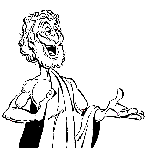|


| |  |
Chess playing has been practised in Chécy for as long as could be remembered.
According to the legend, it is a Greek named Palamede, who, bored with the long war of Troy (or was it Troyes ...?) , brought the game to Chécy. It is a historical fact that Brahma SISSA ( his name, slightly modified , would later be given to our place), once in a state
of trance, developed here, in Chécy, the well-known tale of the Grains of Corn. | |
Sissa addressing the
corn fields near Orléans
|
|
Chessboards dated from 3000 years or more were found during archeological diggings in the quarter "Vieux Pavé". Apparently, the aim consisted already, from the beginning, in moving pawns over a square board. But the present game was imported from India or China in the 6th Century ( precisely on a 27th of February around 3
pm ). It was then called Tchaturanga or The Game of the Four Kings and was played between four opponents, each acting for himself. The tokens were, for each player : one ship, one horse, one elephant, one king and four pawns. |

| |
Old chessboard found on the "vieux pavé" quarter |
|
In the Middle-Ages, chess had already become very popular. It is said that a young girl travelling all the way from Lorraine arrived at Checy by a weekend of April 1429 in order to be trained on the game....
Due to a shortage of suitable players in or around Chécy, it was progressively decided to set the available ones in teams of two by two. Later on the pawns were grouped side by side and the leadership of each team was entrusted to a single player. The game had evolved
into its final and present shape. |
|
PSomewhat fallen into disuse towards the 19th Century, since people had other rural burdens on their hands, (such as mildew and phylloxera in their vine yards) the game of chess was brought back to fame in 1978 by Antoine Esteban : the Chess School of Chécy was born.
|
|